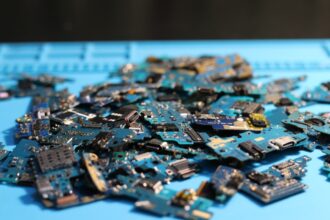Hans von Ohain was born on December 14, 1911, in Dessau, Germany. His early life was marked by a keen interest in engineering and aviation, which would later shape his career and contributions to the field of aeronautics. Growing up in a time when aviation was rapidly evolving, he was captivated by the possibilities of flight.
His family encouraged his intellectual pursuits, and he excelled in his studies, particularly in mathematics and physics. This strong academic foundation would serve him well as he pursued higher education. Ohain attended the University of Göttingen, where he studied mechanical engineering.
His time at the university coincided with significant advancements in aerodynamics and propulsion systems. He immersed himself in the study of jet propulsion, a relatively new concept at the time. His academic endeavors were complemented by practical experience, as he worked on various projects that allowed him to apply theoretical knowledge to real-world challenges.
This combination of education and hands-on experience laid the groundwork for his future innovations in jet engine technology.
Key Takeaways
- Hans von Ohain was born in Germany in 1911 and studied engineering at the University of Göttingen.
- The rise of Nazi Germany provided the backdrop for Ohain’s invention of the jet engine, which he patented in 1936.
- Ohain collaborated with the Nazi regime, receiving funding and support for his jet engine development.
- The impact of the jet engine on World War II was significant, revolutionizing air warfare and leading to the development of jet-powered aircraft.
- Post-war developments and controversies surrounded Ohain’s legacy, as he faced criticism for his collaboration with the Nazi regime.
The Rise of Nazi Germany
The political landscape of Germany underwent a dramatic transformation in the early 1930s with the rise of Adolf Hitler and the Nazi Party. As the nation grappled with economic turmoil and social unrest, the Nazis capitalized on public discontent, promising stability and national rejuvenation. This period saw a surge in militarization and a focus on technological advancements, particularly in the realm of aviation.
The regime’s ambitions for air superiority fueled a race for innovation, creating an environment ripe for engineers like Hans von Ohain to make their mark. As the Nazi regime consolidated power, it prioritized the development of advanced military technologies. The Luftwaffe, Germany’s air force, became a central component of Hitler’s military strategy.
The government invested heavily in research and development, seeking to establish dominance in aerial warfare. This atmosphere of urgency and competition provided von Ohain with both opportunities and challenges as he navigated his career amidst the political upheaval. The intersection of his engineering aspirations with the regime’s militaristic goals would ultimately shape the trajectory of his work.
Hans von Ohain and His Invention

In the late 1930s, Hans von Ohain made a groundbreaking contribution to aviation with the invention of the turbojet engine. While many engineers were exploring various forms of propulsion, von Ohain’s vision was distinct; he sought to create an engine that could harness the power of jet propulsion effectively. In 1937, he successfully tested his first prototype, which marked a significant milestone in aviation history.
This innovation not only demonstrated the feasibility of jet propulsion but also set the stage for a new era in flight. The design of von Ohain’s turbojet engine was revolutionary. It utilized a centrifugal compressor to increase air pressure before it entered the combustion chamber, where fuel was ignited to produce thrust.
This design allowed for greater efficiency and power compared to traditional piston engines. The successful testing of his engine caught the attention of military officials, leading to further development and eventual implementation in aircraft such as the Heinkel He 178, which became the world’s first jet-powered aircraft to fly. Von Ohain’s invention was not merely an engineering triumph; it represented a paradigm shift in aviation technology.
Collaboration with the Nazi Regime
| Organization | Collaboration Type | Extent of Collaboration |
|---|---|---|
| IG Farben | Chemical Industry | Extensive collaboration, including use of forced labor in concentration camps |
| Volkswagen | Automotive Industry | Used forced labor and produced military vehicles for the Nazi regime |
| Krupp | Steel and Arms Manufacturing | Utilized forced labor and produced weapons for the Nazi war effort |
As von Ohain’s work gained recognition, he found himself increasingly intertwined with the Nazi regime’s military ambitions. His collaboration with government officials and military leaders was driven by a shared goal: to advance Germany’s aerial capabilities. While von Ohain was primarily focused on engineering and innovation, he could not ignore the political implications of his work.
The regime’s support provided him with resources and funding that were essential for further development of his jet engine technology. However, this collaboration also raised ethical questions about the role of scientists and engineers in wartime efforts. Von Ohain’s contributions were instrumental in enhancing Germany’s military might, which ultimately had devastating consequences during World War
The Impact of the Jet Engine on World War II
The introduction of jet engines into military aviation had a profound impact on World War
Von Ohain’s innovations allowed for faster and more agile aircraft, fundamentally changing aerial combat dynamics. The Heinkel He 178 and subsequent jet-powered aircraft demonstrated capabilities that outmatched their piston-engine counterparts, leading to a shift in air warfare strategies. The speed and altitude advantages provided by jet propulsion gave Germany a temporary edge in certain battles.

However, despite these advancements, the full potential of jet technology was not realized until later in the war. The logistical challenges of mass production and maintenance hindered widespread deployment of jet aircraft. Nevertheless, von Ohain’s work laid the groundwork for future developments in aviation technology that would shape post-war military strategies globally.
The lessons learned from these innovations would influence air combat for decades to come.
Post-War Developments and Controversies
After World War II ended, Hans von Ohain faced a new set of challenges as he transitioned from a wartime innovator to a peacetime engineer. With Germany’s defeat, many scientists and engineers found themselves grappling with their roles during the conflict. Von Ohain relocated to the United States, where he continued his work in aerospace engineering.
Despite his contributions to aviation, von Ohain’s legacy remained controversial due to his association with the Nazi regime. Critics questioned whether his innovations could be separated from the context in which they were developed.
The ethical implications of collaborating with a totalitarian government loomed large over his achievements. As he navigated this complex landscape, von Ohain sought to redefine his identity as an engineer committed to advancing technology for peaceful purposes.
Ohain’s Legacy and Recognition
Hans von Ohain’s legacy is multifaceted, reflecting both his groundbreaking contributions to aviation technology and the ethical complexities surrounding his work during World War
However, recognition came with an awareness of the moral implications tied to his past. As society grappled with the consequences of technological advancements during wartime, von Ohain’s story became emblematic of the broader ethical dilemmas faced by scientists and engineers throughout history. His legacy serves as a reminder that innovation can have far-reaching consequences, both positive and negative.
The Influence of Nazi Germany’s Jet Engine Technology
The technological advancements made during Nazi Germany’s pursuit of jet propulsion had lasting effects on global aviation development.
The knowledge gained from these efforts influenced post-war aviation technology across various nations.
In particular, countries such as the United States and Britain capitalized on German jet technology after the war ended. Many former German scientists were brought to America through programs like Operation Paperclip, where their expertise contributed to advancements in aerospace engineering during the Cold War era. The legacy of Nazi Germany’s jet engine technology thus extended beyond its immediate applications during World War II; it shaped future developments in both military and civilian aviation.
Ethical and Moral Considerations
The story of Hans von Ohain raises important ethical questions about the responsibilities of scientists and engineers in times of conflict. As technological advancements continue to shape modern warfare, it is crucial to consider how innovations can be used for both constructive and destructive purposes. Von Ohain’s collaboration with the Nazi regime exemplifies the moral dilemmas faced by individuals working within oppressive systems.
The ethical considerations surrounding scientific research are particularly relevant today as society grapples with issues such as artificial intelligence, biotechnology, and environmental sustainability. The lessons learned from von Ohain’s experiences highlight the importance of maintaining ethical standards in research and development while recognizing the potential consequences of technological advancements on humanity.
Lessons Learned from History
History offers valuable lessons regarding the intersection of technology and ethics, particularly in relation to wartime innovations like those developed by Hans von Ohain. As societies continue to advance technologically, it is essential to reflect on past mistakes and strive for responsible innovation that prioritizes human welfare over militaristic ambitions. The narrative surrounding von Ohain serves as a cautionary tale about the potential consequences of scientific collaboration with oppressive regimes.
It underscores the need for transparency, accountability, and ethical considerations in research endeavors—principles that should guide future generations of scientists and engineers as they navigate complex moral landscapes.
The Continued Evolution of Jet Engine Technology
Jet engine technology has continued to evolve since Hans von Ohain’s pioneering work in the 1930s. Today’s engines are more efficient, quieter, and environmentally friendly than their predecessors, reflecting advancements in materials science, aerodynamics, and computer modeling techniques. Innovations such as turbofan engines have transformed commercial aviation by providing greater fuel efficiency while maintaining high performance levels.
As society faces new challenges related to climate change and sustainability, ongoing research into alternative fuels and hybrid propulsion systems is becoming increasingly important. The legacy of pioneers like von Ohain serves as both inspiration and cautionary reminder as engineers strive to balance technological progress with ethical considerations in an ever-changing world. In conclusion, Hans von Ohain’s life story encapsulates both remarkable achievements in aviation technology and complex moral dilemmas associated with scientific collaboration during wartime.
His contributions have left an indelible mark on aviation history while prompting critical discussions about ethics within engineering fields—a dialogue that remains relevant today as society continues to navigate technological advancements amidst global challenges.
The invention of the jet engine is often attributed to the pioneering work done during World War II, particularly in Nazi Germany. Hans von Ohain, a German physicist, is credited with developing one of the first operational jet engines, which significantly advanced aviation technology during the war. For a deeper understanding of the technological innovations and historical context surrounding this period, you can explore a related article on the topic by visiting In The War Room. This resource provides insights into the development and impact of the jet engine, highlighting its role in shaping modern aviation.
WATCH THIS! 🪖How Stolen Nazis Built Cold War Power
FAQs
Who invented the jet engine in Nazi Germany?
The jet engine was invented in Nazi Germany by Hans von Ohain and Sir Frank Whittle.
When was the jet engine invented in Nazi Germany?
The jet engine was invented in Nazi Germany in the 1930s, with Hans von Ohain and Sir Frank Whittle both developing their own versions of the jet engine during this time.
What was the significance of the jet engine in Nazi Germany?
The invention of the jet engine in Nazi Germany revolutionized aviation and military technology, leading to the development of jet-powered aircraft that could fly faster and higher than traditional propeller-driven planes.
How did the invention of the jet engine impact World War II?
The invention of the jet engine in Nazi Germany had a significant impact on World War II, as it allowed for the development of advanced jet-powered aircraft such as the Messerschmitt Me 262, which was the world’s first operational jet-powered fighter aircraft.
What were the contributions of Hans von Ohain and Sir Frank Whittle to the development of the jet engine in Nazi Germany?
Hans von Ohain and Sir Frank Whittle both made significant contributions to the development of the jet engine in Nazi Germany, with von Ohain creating the first operational jet engine and Whittle developing his own jet engine design independently around the same time.




